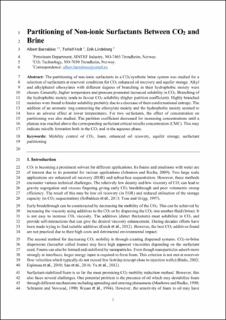| dc.contributor.author | Barrabino, Albert | |
| dc.contributor.author | Holt, Torleif | |
| dc.contributor.author | Lindeberg, Erik Gøsta Brun | |
| dc.date.accessioned | 2022-10-10T10:21:29Z | |
| dc.date.available | 2022-10-10T10:21:29Z | |
| dc.date.created | 2020-10-27T13:57:58Z | |
| dc.date.issued | 2020 | |
| dc.identifier.citation | Journal of Petroleum Science and Engineering. 2020, 190. | en_US |
| dc.identifier.issn | 0920-4105 | |
| dc.identifier.uri | https://hdl.handle.net/11250/3025052 | |
| dc.description.abstract | The partitioning of non-ionic surfactants in a CO2/synthetic brine system was studied for a selection of surfactants at reservoir conditions for CO2 enhanced oil recovery and aquifer storage. Alkyl and alkylphenol ethoxylates with different degrees of branching in their hydrophobic moiety were chosen. Generally, higher temperature and pressure promoted increased solubility in CO2. Branching of the hydrophobic moiety tends to favour CO2 solubility (higher partition coefficient). Highly branched moieties were found to hinder solubility probably due to a decrease of their conformational entropy. The addition of an aromatic ring connecting the ethoxylate moiety and the hydrophobic moiety seemed to have an adverse effect at lower temperatures. For two surfactants, the effect of concentration on partitioning was also studied. The partition coefficient decreased for increasing concentrations until a plateau was reached above the corresponding surfactant critical micelle concentration (CMC). This may indicate micelle formation both in the CO2 and in the aqueous phase. | en_US |
| dc.language.iso | eng | en_US |
| dc.publisher | Elsevier | en_US |
| dc.rights | Attribution-NonCommercial-NoDerivatives 4.0 Internasjonal | * |
| dc.rights.uri | http://creativecommons.org/licenses/by-nc-nd/4.0/deed.no | * |
| dc.title | Partitioning of non-ionic surfactants between CO2 and brine | en_US |
| dc.type | Peer reviewed | en_US |
| dc.type | Journal article | en_US |
| dc.description.version | acceptedVersion | en_US |
| dc.rights.holder | This is the authors’ accepted and refereed manuscript to the article. This manuscript version is made available under the CC-BY-NC-ND 4.0 license | en_US |
| dc.source.pagenumber | 11 | en_US |
| dc.source.volume | 190 | en_US |
| dc.source.journal | Journal of Petroleum Science and Engineering | en_US |
| dc.identifier.doi | 10.1016/j.petrol.2020.107106 | |
| dc.identifier.cristin | 1842623 | |
| dc.relation.project | Norges forskningsråd: 267859 | en_US |
| dc.source.articlenumber | 107106 | en_US |
| cristin.ispublished | true | |
| cristin.fulltext | postprint | |
| cristin.qualitycode | 2 | |

